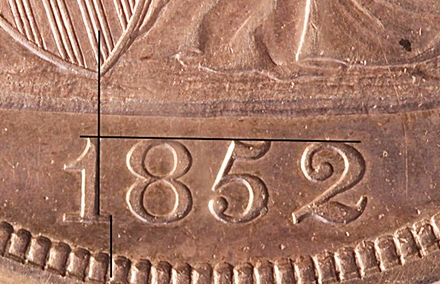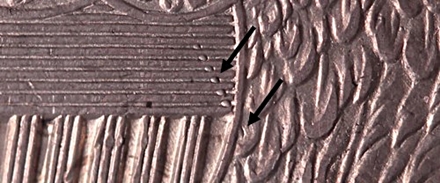1852 OC-2
| Die Pair | P1 - 1848 A |
| Date Grid | LE / 4-1.0 / VS down |
| Obverse Die States | a |
|
| Estimated Rarity | Unconfirmed |
| 1, 2 Vertical | VSH, VSL |
| Reverse Die States | Unconfirmed |
|
Comments:
This die pair has been identified by Dave Bowers, but we’ve been unable to directly confirm its existence.
Obverse P1 was used to strike all 1852 die marriages. This is an early use, but we’ve had no opportunity to directly
compare examples of OC-1, OC-2, and OC-P1, so we can’t conclusively identify the emission sequence of those three
die marriages. Reverse 1848 A was first used in 1848, subsequently in 1849, 1850, and 1851, all to strike business strikes.
|
Obverse P1
The photo below shows the Obverse P1 attribution grid. This obverse die was used for all 1852 die marriages,
both business strikes and proofs.


1852 Obverse P1 attribution grid
Obverse P1 Die States
- Perfect die.
No later die states have been observed.
|
Reverse A
1848 Reverse A was well-documented in Gobrecht Journal issue #120 (reference 11), and again in the sections of this
book which describe the die marriages of 1848, 1849, 1850, and 1851. It was used in each of those 4 years. If an
example of OC-2 is confirmed this would be its fifth use. In the 1851 usage most of the
die lines in the shield recesses had been polished off the die. A new line appeared in 1850, angling across the
horizontal shield lines and across the right shield border. The next photo shows this die line.


1848 Reverse A die line in shield
Reverse A Die States
- Perfect die.
- A light die crack crosses the top of STA.
- Polished dies. The die lines at the top of reverse shield recess #1 and the die crack across the top of STA
are virtually gone.
- Faint die cracks at the top of some of the letters, barely visible under a glass.
- A notable die line slants down through the right side of the horizontal shield lines, extending very slightly
across the shield border and into the feathers on the right. This die line is apparently the result of work on
the die which occurred after its use in 1849 and before its use in 1850.
- A light die line from the top of the left side of the U through the lower tip of the left wing, through
the leaves, ending at the upper left side of the O in DOL.
- Die cracks: one arcs from the field left of the O in DOL up through the bottom of the O back to the denticles
below the right side of the N; another from the denticles below the left wing tip across the top of UNITED,
continuing above S1, back to the denticles at the left edge of T2.
States a through d are found only in usages prior to 1850. Since this use of 1848 Reverse A is unconfirmed we can’t
comment conclusively on the die state. If found we expect that the coin would exhibit reverse die state g.
|
Photo credits:
Obverse P1: 1852 Business Strike PCGS AU details, from the Osburn-Cushing reference collection.
Reverse 1848 A: 1850 NGC AU58, from the Osburn-Cushing reference collection.
|
|


